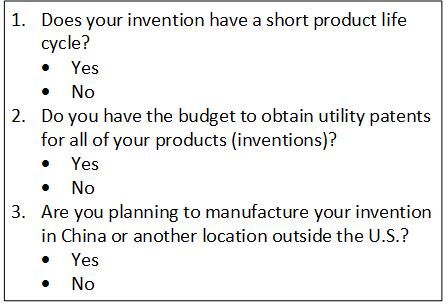
Questionnaire: Is a Design Patent Right for Your Invention?
Informed Decisions: Assessing the Fit for Design Patent Protection
Embarking on the journey of obtaining a design patent is a crucial decision that requires careful consideration. Our Design Patent Evaluation Toolkit is designed to assist both attorneys and inventors in determining whether a design patent is the most suitable form of protection for a given invention. By exploring key factors and answering thought-provoking questions, this guide aims to provide a clear understanding of the design patent process and its potential benefits. Let’s delve into the essential aspects to ensure that your innovative creation receives the protection it deserves.
- Does your invention have a short product life cycle?
- Yes
- No
- If Yes: A design patent may be valuable since it can be obtained relatively quickly and provide protection during the product’s life cycle.
- If No: Consider whether other factors, such as budget constraints or the importance of design, make a design patent a suitable option.
- Do you have the budget to obtain utility patents for all of your products (inventions)?
- Yes
- No
- If Yes: You might still consider a design patent as a complementary form of protection.
- If No: A design patent could be a cost-effective way to protect your product’s appearance.
- Are you planning to manufacture your invention in China or another location outside the U.S.?
- Yes
- No
- If Yes: A design patent can help prevent suppliers from using the same molds or tooling to manufacture products for your competitors.
- If No: Consider other factors, such as the importance of design in your product’s appeal, to determine if a design patent is right for you.
- Do you have an invention that can’t be protected with a utility patent because it doesn’t exhibit any novel functionality?
- Yes
- No
- If Yes: A design patent may be a suitable way to protect the new design of your product.
- If No: Evaluate other aspects, such as the product’s life cycle and budget constraints, to decide on the need for a design patent.
- Do you plan to file a design patent application after filing a provisional patent application?
- Yes
- No
- If Yes: Remember that design patent applications cannot claim priority to provisional applications, so consider filing them simultaneously.
- If No: Assess whether a design patent aligns with your overall intellectual property strategy.
- Does your product include any replacement parts that you want to protect or license?
- Yes
- No
- If Yes: A design patent can be used to protect secondary markets and provide exclusivity in the after-market or replacement market.
- If No: Consider other reasons for obtaining a design patent, such as protecting the product’s overall design or user interface.
- Is your product consumer-facing?
- Yes
- No
- If Yes: A design patent should be considered to protect the product’s appearance and appeal to consumers.
- If No: Evaluate other factors to determine if a design patent is necessary for your intellectual property strategy.
- Do you want to protect the user experience and user interface (UX/UI) of your product?
- Yes
- No
- If Yes: Design patents are increasingly used to protect UX/UI designs, making them an important consideration for technology products.
- If No: Consider whether other aspects of your product’s design might benefit from patent protection.
- Do you need time to create trade dress rights?
- Yes
- No
- If Yes: A design patent can provide exclusivity to help you achieve distinctiveness for your product design and acquire trademark rights.
- If No: Focus on other reasons for obtaining a design patent, such as immediate protection for your product’s design.
- Do you want to co-file utility and design patent applications to maximize protection?
- Yes
- No
- If Yes: This strategy can provide staggered protection and cover both functional and aesthetic aspects of your product.
- If No: Consider whether a design patent alone aligns with your intellectual property goals.
- Do you need faster patent protection, or can you wait up to 5 years for a utility patent?
- Need faster protectionCan wait
- If “Need faster protection”: A design patent might be a suitable option as it generally has a shorter pendency period than a utility patent.
- If “Can wait”: Evaluate other considerations, such as the importance of design and budget constraints, to decide on a design patent.
- Do you want to claim priority between Design and Utility Patent Applications?
- Yes
- No
- If Yes: Consider filing both applications simultaneously or within the priority period to preserve your rights.
- If No: Assess whether a design patent alone meets your needs or if other intellectual property strategies are more appropriate.
Recommended Webinars
Delve deeper into the topics discussed in this article by attending our webinars. These sessions provide further insights and offer the chance to interact with experts in design patent drafting and illustration.
- Design Webinars: Avoiding Non-Correctable Errors in Design Patents:: Discover how to avoid non-correctable errors in design patents and ensure the success of your applications in this informative webinar by IP DaVinci.
- Design Webinars: Handling Advanced Scenarios in Design Patents: Explore strategies for handling advanced scenarios in design patents in this insightful webinar by IP DaVinci, enhancing your ability to navigate complex cases.
- Design Webinars: Cost and Time Saving Tips for Design Patent Drawings: Learn cost and time-saving tips for design patent drawings in this practical webinar by IP DaVinci, aimed at streamlining your patent application process.
Provide Feedback
We value your feedback! Let us know how we can improve or what topics you’d like to see next.
Connect with Mike
Have questions or need support? Connect with Mike for personalized assistance.
Share Your Experience
Found our series helpful? Share it with your network and help others benefit too!